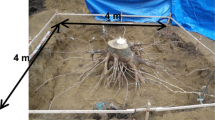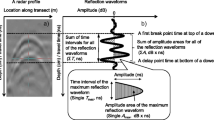Abstract
It has been reported that ground-penetrating radar (GPR) is a nondestructive tool that can be used to detect coarse roots in forest soils. However, successful GPR application for root detection has been site-specific and numerous factors can interfere with the resolution of the roots. We evaluated the effects of root diameter, root volumetric water content, and vertical and horizontal intervals between roots on the root detection of Cryptomeria japonica in sand using 900-MHz GPR. We found that roots greater than 19 mm in diameter were clearly detected. Roots having high volumetric water content were easily detected, but roots with less than 20% water content were not detected. Two roots that were located closely together were not individually distinguished. These results confirm that root diameter, root water content, and intervals between roots are important factors when using GPR for root detection and that these factors lead to an underestimation of root biomass.






Similar content being viewed by others
Abbreviations
- GPR:
-
ground-penetrating radar
References
Barton CVM, Montagu KD (2004) Detection of tree roots and determination of root diameters by ground penetrating radar under optimal condition. Tree Physiol 24:1323–1331
Brunner I, Godbold DL (2007) Tree roots in a changing world. J For Res 12:78–82 doi:10.1007/s10310-006-0261-4
Butnor JR, Doolittle JA, Kress L et al (2001) Use of ground-penetrating radar to study tree roots in the southeastern United States. Tree Physiol 21:1269–1278
Butnor JR, Doolittle JA, Johnsen KH et al (2003) Utility of ground-penetrating radar as a root biomass survey tool in forest systems. Soil Sci Soc Am J 67:1607–1615
Cermak J, Hruska J, Martinkova M et al (2000) Urban tree root systems and their survival near houses analyzed using ground penetrating radar and sap flow techniques. Plant Soil 219:103–116 doi:10.1023/A:1004736310417
Cox KD, Scherm H, Serman N (2005) Ground-penetrating radar to detect and quantify residual root fragments following peach orchard cleaning. Horttechnology 15:600–607
Dannoura M, Hirano Y, Igarashi T et al (2008) Detection of Cryptomeria japonica roots with ground penetrating radar. Plant Biosyst 142:1–8 doi:10.1080/11263500802150951
Hagrey SA (2007) Geophysical imaging of root-zone, trunk, and moisture heterogeneity. J Exp Bot 58:839–854 doi:10.1093/jxb/erl237
Hirano Y, Mizoguchi T, Brunner I (2007) Root parameters of forest trees as sensitive indicators of acidifying pollutants-a review of research of Japanese forest trees-. J For Res 12:134–142 doi:10.1007/s10310-006-0263-2
Hruska J, Cermak J, Sustek S (1999) Mapping tree root systems with ground-penetrating radar. Tree Physiol 19:125–130
Karizumi N (1976) The mechanism and function of tree root in the process of forest production III. Root density and absorptive structure. Bull Gov For Exp Sta 285:43–149
Miller TW, Hendrickx JMH, Borchers B (2004) Radar detection of buried landmines in field soils. Vod Zone J 3:1116–1127
Milsom J (2003) Ground penetrating radar. In: Milsom J (ed) Field geophysics. 3rd edn. Wiley, New Jersey, pp 167–178
Stokes A, Fourcaud T, Hruska J et al (2002) An evaluation of different methods to investigate root system architecture of urban trees in situ: I. Ground-penetrating radar. J Arboricult 28:2–10
Stover DB, Day FP, Butnor JR et al (2007) Effect of elevated CO2 on coarse root biomass in Florida scrub detected by ground-penetrating radar. Ecology 88:1328–133 doi:10.1890/06-0989
Strand AE, Pritchard SG, McCormack ML et al (2008) Irreconcilable differences: Fine-root life spans and soil carbon persistence. Science 319:456–458 doi:10.1126/science.1151382
The Government of Japan (2008) Report on Japan’s supplementary information on LULUCF activities under article 3, paragraphs 3 and 4 of the Kyoto Protocol
Acknowledgements
This study was supported by a Grand-in-Aid for Scientific Research from the Ministry of Education, Culture, Sports, Science and Technology, Japan (No. 18380095). We thank T. Chikaguchi, S. Narayama and M. Tanaka, of the Kansai Research Center, FFPRI, for preparation of the roots and experimental field.
Author information
Authors and Affiliations
Corresponding author
Additional information
Responsible Editor: Hans Lambers.
Rights and permissions
About this article
Cite this article
Hirano, Y., Dannoura, M., Aono, K. et al. Limiting factors in the detection of tree roots using ground-penetrating radar. Plant Soil 319, 15–24 (2009). https://doi.org/10.1007/s11104-008-9845-4
Received:
Accepted:
Published:
Issue Date:
DOI: https://doi.org/10.1007/s11104-008-9845-4




